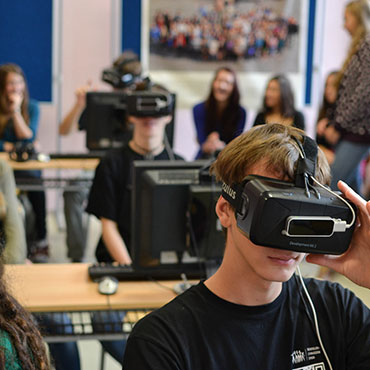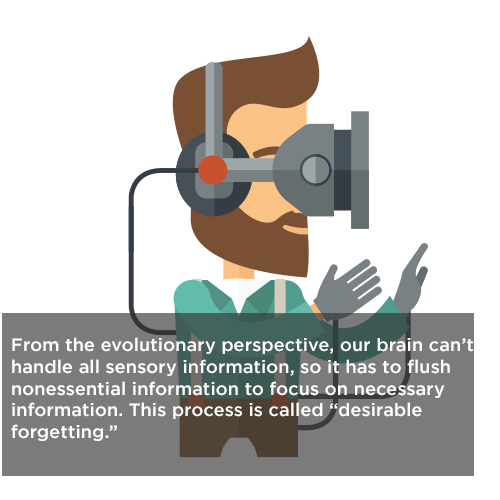
How Can Virtual Reality Be Used to Promote Retention?
[vc_row][vc_column width=”1/2″][vc_column_text]
How Can Virtual Reality Be Used to Promote Retention?
Corporate America invests about $60 billion dollars a year in training and workforce development, but research shows that only a small number of employees who receive training can remember information to enhance to their jobs. But, the question is why not this enormous investment pay off?
Usually, students, trainers, or, even, lessons are blamed for low retention; but, I believe the biggest problem is rooted in the lack of understanding about how our brain learns and retains information. In other words, we have to pay attention the limitations of the brain when designing or teaching a course or delivering training.

How do we process information?
Any information that needs to be processed by our brain has to be picked up by our ears or eyes, and this information is held by our sensory memory for only a split second. Yet, just a small amount of information goes on to the next stage of memory: working memory. Working memory is what allows you to hold onto multiple pieces of information in order to complete cognitive tasks, such as comprehending this article. Once the information is processed, working memory sends it to long-term memory. Working memory is manageable, but it has space and duration limitations when dealing with new, unfamiliar information because it can only hold 5 to 9 elements for about 20 seconds and process only two to four elements at a time. In contrast, long-term memory keeps permanent information to be retrieved when necessary. The processed information in working memory is stored in long-term memory. Even though working memory has limits for the amount of information to process and duration of information to keep, working memory is not subject to these limitations when information is retrieved from long-term memory because stored information is treated as one element in working memory, no matter how complex it is. In other words, we do not process or store any information if information is not engaging, meaningful, and emotionally compelling enough to go through our sensory memory. Yet, not all educational materials are designed to enable learners to store and retrieve all essential information, and this causes enormous losses.[/vc_column_text][/vc_column][vc_column width=”1/2″][vc_column_text]
Forgetting: a human feature
Chances are you think you are good at remembering. People’s appraisal of their memory is much like their assessment of their driving skills, in that the great bulk of adults think they’re above average. However, neuroscientists believe that forgetting is an essential part of memory. From the evolutionary perspective, our brain can’t handle all sensory information, so it has to flush nonessential information to focus on necessary information. This process is called “desirable forgetting.” However, our brain is not capable of determining which information is essential, and it may flush out important information resulting in “undesirable forgetting.” One way to help our brain retain information is to explore ways to decrease undesirable forgetting. Henry Roediger, a professor at Washington University in St Louis, has studied possible ways to minimize undesirable forgetting for almost forty years. According to him, we can stimulate our brain when a particular piece of information needs to be stored in our long-term memory, which will increase our retention rate.
So, how is this related to Virtual Reality?
Learners of all ages typically retain between 10% and 30% of that they read and see. Traditional educational approaches usually fail to help us retain information because they do not stimulate our brain as much as Virtual Reality.
Aukstakalnis and Blatner defines virtual reality as “a way for humans to visualize, manipulate, and interact with computers.” Careful research shows that the use of virtual reality in education increase learners’ performance and retention by 35% because virtual reality ignites our brain as visual stimuli impinge on our eyes, and spoken words or music impinge on our ears. When we attend to the incoming sounds and images, both will pass our sensory memory to be processed in our working memory, and therefore, it is more likely to be stored in our long-term memory. Every time we are exposed to the same sounds and images, not only we will be able to retrieve that information easily, also we will remember the details of that lesson. Moreover, the VR technology enables the delivery of specific, consistent, and relevant context that allows learners to immerse in a virtual world. This immersion tricks our senses by increasing electrical activity in our brain. Electrical activities increase as VR enables a learner to look all around, internalize the environment, and move through scenes, which makes the learning experience incredibly realistic and very memorable.
Long story short, virtual reality has the potential to create training that increases retention and performance; hence, VR may make money spent in training worthwhile.
Author: Filiz Aktan PhD Canidate[/vc_column_text][/vc_column][/vc_row]
Comments (2)
-
pkrvipgame
Yo, check out pkrvipgame! Just stumbled upon it and it’s pretty legit. Good variety of games, if you’re into that kinda thing. Hit it up here: pkrvipgame


pkr333
Alright, poker faces assemble! PKR333’s got some sweet poker action. Decent traffic and some pretty soft tables if you ask me. See you at the tables when you join pkr333!